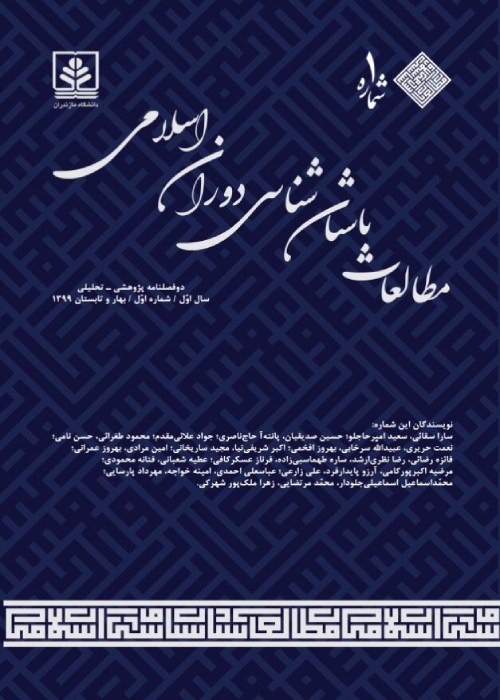An Investigation on Social Status of Asadabad during the Safavid Period Based on Documentary Sources and Inscriptions
Theatrical advances in historical sciences such as archaeology and history have caused the motivation for understanding the social status of historical periods. Therefore, understanding the social status not only in the national scale, but also in regional or local scale is very important. It means historians and archaeologists have to analyze and interpret some materials, evidence and documents about social status of the defined geographical region for study purposes. Very significant information about economic and social status can be resulted from these kinds of studies. It must be emphasized that these types of studies are very essential for some historical periods which are significant for their social transformations. The Safavid period is one of the most important and effective periods in Iranian history. Rising of the Safavid state in Iran was not only a political change. Iranian society have experienced deep and multifaceted transformations during the Safavid period. Rising of the Safavid role with its special characteristics such as declaring Shiite as official religion, the establishment of a powerful and central government and a precise economic and financial system, had social consequences in different parts of Iran. These consequences made Safavid’s society very different from the past. During the Safavid period, there were considerable happenings that entailed fundamental changes in the cultural and social situation within the country. Shiite became the official religion, there were established safety everywhere and measures taken like that caused evolutionary changes in the social structure making it like a pyramid at the top, which was the Safavid Shah and at the base were the ordinary people including shopkeepers, workers, peasants, and farmers. The religious army and civil authorities were in the middle of this pyramid. We have to keep in mind that understanding the social status, which is a consequence of political power, is very important for historians and archaeologists. Social transformations of the Safavid period in different parts of Iran have been manifested in different ways and these transformations have been documented in some historical sources. These sources are very important in the study of local history. Asadabad at the west of Iran has some geographical privileges that has provided a good opportunity for interaction with other regions; also, from the landscape point of view, Asadabad has been a suitable area for agriculture and livestock during the history. Asadabad as a part of the Safavid society has experienced social transformations during the Safavid period. Historical texts and some other historical-geographical sources have not presented enough information about the social conditions of the Asadabad during the Safavid period. Although there are some historical sources that have mentioned Asadabad, but the information that they present is very general and the social status is not understood by those sources. Although historical sources are almost silent about the social condition of Asadabad during the Safavid period, there are some inscriptions that are very significant in this sense; so the main question of this paper is: How can social condition of Asadabad during the Safavid period be understood by studying the Safavid inscriptions?
This main question gives a purpose to this paper and defines the paper's main goal. The main goal of this paper is to understand the social status of Asadabad during the Safavid period. Inscriptions mentioned above are some governmental orders that have issued in accordance with the social status of Asadabad. On one side, these inscriptions are first-hand historical sources. Inscriptions must be reviewed to achieve this goal. These texts must be interpreted in their historical context which is the methodological approach of this study. The content of the Safavid inscriptions in Asadabad in chronological order are: Shah Tahmasp I’s order about tax forgiveness of Asadabad, Shah Tahmasp I’s order about livestock tax rebate of Asadabad, Abbas the Great’s order about tax rebate of Asadabad in Ramadan of 1026 A.H, Shah Safi’s order about tax forgiveness of Asadabad, Shah Suleiman Safavi's order about repairing Jameh Mosque of Asadabad and other inscriptions about building a dam around Asadabad. These inscriptions have been interpreted in their historical context and as a result, some issues about Asadabad’s social status during the Safavid period are understood.
Based on our studies, we know that Asadabad has experienced a deep transformation in terms of its people’s religion. Based on Safavid inscriptions, we know that the people of Asadabad have been practicing Shia and it seems this profound transformation was in the line with Safavid’s religious policies, because being Shia was supported and encouraged by the Safavid Shahs by forgiving the taxes. Abbas the Great’s order about tax forgiveness was only dedicated to Shi'ite Muslims and Shah Tahmasp I’s reason for tax forgiveness of Asadabad was the fact that the people of Asadabad were Shi'ites. Moreover, with the interpretation of inscriptions, we know that in the Safavid period, Asadabad was part of a province named Sonqor and Dinevar and also it was a center of federal services for the surrounding villages; This means the economic status of Asadabad in the Safavid period was dependent on the rural economy, especially agriculture and livestock productions.
Based on our results, we know that the society of Asadabad in the Safavid period has experienced great transformations. One of the most important factors in these transformations is religion. Practicing Shia Islam by the people of Asadabad was encouraged by Safavid Shahs in different ways such as tax forgiveness and rebating tax which is worth noting that in one case, Shah’s favor only included Shi'ites.The location Asadabad in political geography of the Safavid period is another issue which is understood in the Safavid inscriptions. Asadabad was in Sonqor and Dinevar province and it was considered as a federal center for surrounding villages.
- حق عضویت دریافتی صرف حمایت از نشریات عضو و نگهداری، تکمیل و توسعه مگیران میشود.
- پرداخت حق اشتراک و دانلود مقالات اجازه بازنشر آن در سایر رسانههای چاپی و دیجیتال را به کاربر نمیدهد.


